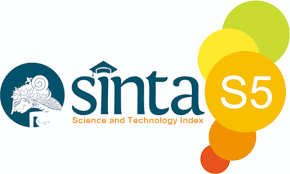Pengurangan Risiko Bencana: Korelasi Pengetahuan dan Kesiapsiagaan Siswa Sekolah Menengah Atas di Kota Batu
DOI:
https://doi.org/10.30872/geoedusains.v4i1.1940Keywords:
Disaster, Knowledge, Preparedness, StudentAbstract
Internalization of disaster risk reduction (DRR) education in the school curriculum has been applied to various levels of education in Indonesia. Given that disaster knowledge is closely related to preparedness, the relevance of both becomes something essential to study. This study aims to 1) describe the level of knowledge of high school students regarding DRR and their preparedness to face disasters, 2) explore the relationship between DRR knowledge and student preparedness to face disasters. This research is a descriptive correlative study. This research was conducted in Batu City which has a status of a multi-disaster prone area. The data collection was done by survey. The number of research samples were 240 students spread across SMAN 1 Kota Batu, SMAN 2 Kota Batu, SMAN 3 Kota Batu, and SMA Islam Kota Batu. The research data was analyzed using Spearman's nonparametric test with a significance of 0.01. The results of the study showed that the student's DRR knowledge level belonged to the category of "understanding" and the level of preparedness of the students was categorized as "ready". Furthermore, there is a positive and significant relationship between two variables studied with a correlation coefficient value of 0.711.
Downloads
References
Aghaei, N., Seyedin, H., Sanaeinasab, H., (2018) Strategies for disaster risk reduction education: A systematic review. Journal Education & Health Promotion.
Amri, A., Bird, D.K., Ronan, K., Haynes, K., Towers, B., (2017) Disaster risk reduction education in Indonesia: challenges and recommendations for scaling up. Natural Hazards Earth System Science, pp 595-613
Andespa, D., & Fauzi, A. (2019). Analysis of senior high school student preparedness in dealing with earthquake disaster in the Mentawai island. In Journal of Physics: Conference Series (Vol. 1185, No. 1, p. 012081). IOP Publishing.
Badan Penanggulangan Bencana Daerah Kota Batu (2018) Peta rawan bencana alam. https://ppid.batukota.go.id/daftar_informasi/detail/peta-rawan-bencana-alam-kota-batu_tahun-2018_badan-penanggulangan-bencana-daerah . Diakses 28 September 2021
BNPB (2015) Indonesia:national progress report on the implementation of Hyogo Framework for Action (2013-2015). BPNB, Jakarta
BNPB (2017). Buku Pedoman Latihan Kesiapsiagaan Bencana. Direktorat Kesiapsiagaan Deputi Bidang Pencegahan dan Kesiapsiagaan BNPB. Jakarta.
Budiwaskito, Raihan. (2010) Margin of Error. Makalah Seminar Probabilitas dan Statistik tahun 2010. ITB, Bandung
DIBI (2021) Data bencana Indonesia. https://dibi.bnpb.go.id/ . Diakses 21 Agustus 2021
Djalante, R., Garschagen, M., Thomalla, F., Shaw, R., (2017) Introduction: disaster risk reduction in Indonesia: progress, challenges, and issues. In: Djalante et al. (eds) Disaster risk reduction in indonesia. Springer International Publishing, pp 1-17
EM-DAT (2016) Disaster profile: Indonesia. http://www.emdat.e/country_profile/index.html. Diakses 26 Agustus 2021
Fatmawati, A., Prastya, A., Suhartanti, I., & Ariyanti, F. W. (2020). Effect of Disaster Simulation Methods on Students Disaster Management Knowledge and Skills at STIKes Majapahit Mojokerto. NurseLine Journal, 5(1), 220-224.
Firdaus, H.S., & Sukojo, B.M. (2015) Pemetaan daerah rawan longsor dengan metode penginderaan jauh dan operasi berbasis spasial studi kasus Kota Batu Jawa Timur. Jurnal Geosaintek. Pp 25-35
Firman, T (2016) Demographic patterns of Indonesia’s urbanization, 2000-2010: continuity and change at the macro level. In: Contemporary demographic transformations in China, India and Indonesia: Springer, pp 255-269
Gay, L.R. & Diehl, P.L (1992) Research Methods for Bussiness and Management, New York: Mc. Milan Publishing.
Guyette, Susan (1983) Community based research: A handbook for native americans. Los Angels: UCLA
Gwee Q, Takeuchi Y, Jet-chau W, Shaw R (2011) Disaster education system in Yunlin county, Taiwan. Asian Journal Environment Disaster Management 3 (2):189–204
Hariyanto, S., Kurniawati, . and Waloejo, C. (2018). The Effect of Simulation Method for Flood Disaster Preparedness towards Nursing Students Faculty of Health Sciences Unipdu, Jombang, East Java, Indonesia. In Proceedings of the 2nd International Conference Postgraduate School (ICPS 2018), pages 422-425.
Hsu, Y. J., Simons,M., Avouac, J.P., Galeteka, J., Sich, K., Chilieh, M., (2006) Frictional afterslip following the 2005 Nias-Simeulue earthquake, Sumatera. Journal Science, pp 1921-1926
Kamil, P. A., Utaya, S., Sumarmi, & Utomo, D. H. (2020). Strengthen Disaster Preparedness for Effective Response on Young People through Geography Education: A Case Study at School in the Tsunami Affected Area of Banda Aceh City, Indonesia. IOP Conference Series: Earth and Environmental Science, 412, 012016.
Khadka, Jiban. (2019). Sampling error in survey research. International Journal of Science and Research (IJSR) 8 (1): 2214-2220
Kruger, J., Brener, N., Leeb, R., Wolkin, A., Avchen, R. N., & Dziuban, E. (2018). School District Crisis Preparedness, Response, and Recovery Plans—United States, 2006, 2012, and 2016. Morbidity and Mortality Weekly Report, 67(30), 809.
Lin, C.K., Nifa, F.A.A., Musa, S., Shahron, S.A., Anuar, N.A, (2016) Challenges and opportunities of disaster education program among UUM student. Proceedings of the 3rd International Conference on Applied Science and Technology (ICAST’18). https://doi.org/10.1063/1.5055440
LIPI & UNESCO/ISDR. (2006). Kajian Kesiapsiagaan Masyarakat dalam Mengantisipasi Bencana Gempa bumi & Tsunami. Jakarta: Deputi Ilmu Pengetahuan Kebumian Lembaga Ilmu Pengetahuan Indonesia.
Mamon, M.A.C., Suba, R.A.V., Son Jr, I.L. (2017) Disaster risk reduction knowledge of grade 11 students: impact of senior high school disaster education in the Philippines. International Journal of Health System and Disaster Management, pp 69-74
Mutasa, S., & Munsaka, E. (2019). Botswana and international policies on the inclusion of disaster risk reduction in the school curriculum: Exploring the missing link. International Journal of Disaster Risk
Nipa, T. J., Kermanshachi, S., Patel, R., & Tafazzoli, M. (2020, September). Disaster preparedness education: construction curriculum requirements to increase students’ preparedness in pre-and post-disaster activities. In Associated Schools of Construction (ASC) International Conference.
Nurdin, N. (2019) Disaster risk reduction in education and the secondary high school science curriculum in Indonesia. Thesis. University Collage London.
Petal M (2009) Education in disaster risk reduction. In: Shaw R, Krishnamurthy RR (eds) Disaster management: global challenges and local solutions. Universities Press, India, pp 285–301
Petal M, Green R, Kelman I, Shaw R, Dixit A (2008) Community-based construction for disaster risk reduction. In: Bosher L (ed) Hazards and the built environment: attaining built-in resilience. London: Taylor and Francis.
Rambau, T. S., Beukes, L. D., & Fraser, W. (2012). Disaster Risk Reduction through school learners’ awareness and preparedness. Jàmbá: Journal of Disaster Risk Studies, 4(1), 1-1.
Ronan, K. R.(2014) Advances and Continuing Challenges towards HFA2 and Post-2015: Background Chapter. UNESCO and UNICEF. Paris, France-Geneva, Switzerland.
Ruminta & Handoko (2011) Kajian risiko dan adaptasi perubahan iklim pada sektor pertanian di Malang Raya. Laporan Penelitian. KLH Jakarta
Saris, W.E & Gallhofer, I.N (2007) Design, evaluation, and analysis of questionaires for survey research. New Jersey: John Wiley & Sons Inc
Selby, D. & Kagawa, F.(2012) Disaster Risk Reduction in school Curricula: Case Study from Thirty Countries. UNESCO and UNICEF. Paris, France-Geneva, Switzerland.
Seneviratne, T. K. K., Amaratunga, D., Haigh, R., & Pathirage, C. P. (2010). Knowledge management for disaster resilience: Identification of key success factors. In: CIB 2010, 10-13th May 2010, University of Salford.
Shaw R (2013) East Japan earthquake and tsunami: key lessons on education, communication, evacuation and volunteerism. In: Kapuchu M, Liu T (eds) Disaster and development: issues and country studies. Elsevier, The Netherlands
Shaw, R., Fernandez, G., Fuhisawa, M., Ichinose, T., Iwamoto, W., Koganegawa, T., Nakamura, T., Oikawa, Y., Shibao, T., Suzuki, K., Thi, T.T.M. (2014) Education for Sustainable Development and Disaster Risk Reduction. Springer, Japan
Shiwaku, K., & Shaw, R. (2008). Proactive co‐learning: a new paradigm in disaster education. Disaster Prevention and Management: An International Journal. pp 183-198.
Sofa, Hanifah Maiya. (2019) Pola diseminasi informasi bencana dan penanggulangan bencana kepada masyarakat Kota Batu. Tesis. Universitas Muhammadiyah Malang.
Stikova, Elisaveta. (2016). Disaster Preparedness. South Eastern European Journal of Public Health Special Volume 2016: A Global Public Health Curriculum; 2nd Edition.
Sujarweni, V. W. (2014). Metodologi penelitian keperawatan. Yogyakarta: Penerbit Gava Media
Sujarwo, Noorhamdani, Fathoni, M., (2018) Disaster risk reduction in schools: the relationship of knowledge and attitudes towards preparedness from elementary school students in school based disaster preparedness in the Mentawai Island, Indonesia. Prehospital and Disaster Medicine, pp 581-586 DOI: https://doi.org/10.1017/S1049023X18000778
Suppasri, A., Imamura, F., Koshimura, S., (2012) Tsunamigenic ratio of the Pacific Ocean earthquakes and a proposal for tsunami index. National hazards Earth System Science, pp 175-185.
Takahashi, K., Kodama, M., Gregorio, E. R., Tomokawa, S., Asakura, T., Waikagul, J., & Kobayashi, J. (2015). School Health: An essential strategy in promoting community resilience and preparedness for natural disasters. Global Health Action, 8(1), 29106.
Thomas, T. N., Leander-Griffith, M., Harp, V., & Cioffi, J. P. (2015). Influences of Preparedness Knowledge and Beliefs on Household Disaster Preparedness. MMWR. Morbidity and Mortality Weekly Report, 64(35), 965–971.
Tipler, K., Tarrant, R., Johnston, D., & Tuffin, K. (2017). Are you ready? Emergency preparedness in New Zealand schools. International journal of disaster risk reduction, 25, 324-333
Tuladhar, G., Ryuichi, Y., Dahal, R.K, Bhandary, N.P., (2014) Knowledge of disaster reduction among school students in Nepal. Geomatics Natural Hazard and Risk, pp 190-207
Tuswadi & Hayashi. T. (2014) Disaster Prevention Education in Merapi Volcano Area Primary Schools: Focusing on Students’ Perception and Teachers’ Performance, Procedia Environmental Sciences, pp 668 – 677.
UNISDR (2006) Newsletter ISDR Inform – Latin America and the Caribbean. No13/2006Disaster risk reduction begins at school. https://www.eird.org/eng/revista/no_13_2006/index_no13ing.htm
UNISDR (United Nations International Strategy for Disaster Risk Reduction) (2009) UNISDR Terminology on Disaster Risk Reduction. Geneva: UNISDR
UNISDR,(2005) Hyogo framework for action 2005–2015: building the resilience of nations and communities to disasters. UNISDR. Geneva, Switzerland.
UNISDR,(2015) Sendai framework for disaster risk reduction 2015–2030. UNISDR. Geneva, Switzerland.










